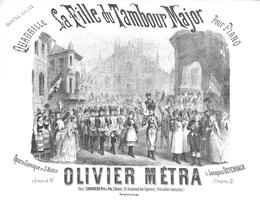La Fille du tambour-major

Opéra-comique in three acts and four tableaux premiered at the Théâtre des Folies-Dramatiques (Paris) on 13 December 1879.
After the French defeat of 1870 and the experience of the Commune, Offenbach, who had fled to Spain, rediscovered Paris under a different light. Theatre audiences were marked by recent history, and the composer had to renew his style to face the competition of Viennese operetta. He reunited with former collaborators, Duru and Chivot – although they were the regular librettists of his young rival Lecocq – in a topical scenario reminiscent of references such as La Chartreuse de Parme or La Fille du régiment. In a North-Italian convent, deserted at the approach of a group of French soldiers, Stella has been left alone. Unknowingly, she meets both her real father, Drum-Major Monthabor, and her future husband, Lieutenant Robert. While her adoptive father, Duke Della Volta, wishes to marry Stella to Marquis Bambini, Monthabor understands that he has found his daughter. When the French soldiers arrive in Milan, the Duke, in a sudden volte-face, sanctions the union of Robert and Stella. Within this unoriginal argument, the librettists were careful to develop Monthabor's paternal feelings. In turn, Offenbach had the foresight to multiply the very fashionable patriotic parades, which he mixed with his own style, quoting himself, in an impulse aimed straight at the heart of listeners nostalgic for pre-war society. On the evening of 13 December 1879, at the Folies-Dramatiques, so many numbers were encored that the work was almost heard twice! Its hundredth performance was given in front of soldiers of the Paris garrison, and it was still on the bill, totalling over two hundred performances, in October 1880 when Offenbach died.




